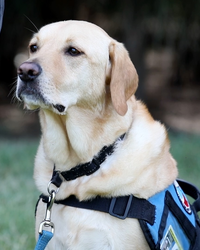Any driver who is providing passenger services in a taxi or hire vehicle (including rideshare) cannot refuse to transport a passenger with an assistance animal or an assistance animal in training.
Assistance animals are trained to aid people with a disability. These assistance animals are not pets. They provide an important service to people who have a disability by helping to alleviate the effect of that disability. Travelling in taxis and hire vehicles (including rideshare) gives people with assistance animals freedom of choice when planning their journey.
This fact sheet answers some frequently asked questions that the Point to Point Transport Commissioner receives and will help passengers, drivers, and service providers to understand their obligations.
Frequently asked questions
What is an assistance animal?
There are many types of assistance animals in NSW, however most fall into the following categories:
- Guide Dogs or Seeing Eye Dogs
- Hearing assistance dogs
- Physical assistance animals
- Psychiatric assistance animals
- Other assistance animals who are trained to assist people with disabilities such as epilepsy and dementia.
Note: On occasion, an animal that is not a dog may also be an assistance animal.
How can a driver identify an assistance animal?
Most assistance animals wear some form of identification. Examples of identification worn by assistance animals include vests, harnesses or collars identifying that they are associated with an assistance animal training organisation.
Passengers may also carry evidence of their assistance animal’s accreditation. However, passengers may have another form of identification, certification, or other evidence to identify the animal as an assistance animal. Some examples of identification are those that have been recognised for use on public transport in NSW which is available on the Transport for NSW website under ‘Accepted types of valid assistance animal accreditation’ (transportnsw.info).
What disabilities do people have, who need assistance animals?
The term ‘disability’ covers a wide range of physical and psychological conditions.
Not all disabilities are visible disabilities. While some people may travel with walking canes, mobility aids, hearing aids or other physical aids, some people may not have any visible signs of their disability. This can include people suffering from PTSD, early onset dementia, epilepsy, among others.
Passengers travelling with an assistance animal should not be asked what their disability is or anything about their disability.
Can a driver refuse service to a passenger who has an assistance animal?
No.
Under the Point to Point Transport (Taxis and Hire Vehicles) Regulation 2017, the driver of a passenger vehicle must not refuse to carry an assistance animal or an assistance animal in training in or on the vehicle. This means a driver cannot refuse service to a person accompanied by an assistance animal. Both the passenger and the assistance animal must be permitted in the vehicle and provided a passenger service – this is for both booked services and rank and hail.
What if the driver is allergic to dogs or animals?
Allergies to dogs or other animals is not a legitimate reason for refusing a passenger with an assistance animal. Drivers who suffer allergies must always be prepared for any situations that may trigger their symptoms.
What if a driver does not want an animal in their vehicle for religious or cultural reasons?
Religious or cultural reasons/beliefs are not an acceptable reason to refuse service to a passenger with an assistance animal.
Accepting assistance animals in a taxi or hire vehicle (including rideshare) is a requirement for drivers providing passenger services in NSW.
A driver must not, without reasonable cause, refuse to allow an assistance animal in their vehicle when the animal is accompanying a passenger with a disability and legitimately assisting that passenger.
How should a driver interact with an assistance animal?
- Please don’t touch, talk, feed or otherwise distract the assistance animal
- Do not treat the animal as a pet, give it the respect of a working animal
- Do not speak to or give the animal any commands unless the passenger asks you to
- Speak to the handler, not their assistance animal
Where in the vehicle should the assistance animal sit?
Assistant animals usually sit in one of the footwells of the vehicle.
They are trained to sit in either the front passenger footwell, or the back passenger footwell. The driver should move the passenger seat all the way backwards or all the way forwards to make extra space for the passenger and their assistance animal.
The assistance animal does not need to be secured in the vehicle and should never be separated from their handler. However, the safety of the assistance animal, passenger and driver should be ensured, and the driver must maintain proper control of the vehicle and full visibility of the road at all times.
Does a vehicle need to be cleaned after an assistance animal has been inside?
No, not typically. Assistance animals are trained animals and are required to meet a high standard of hygiene and behaviour. Vehicles usually do not need to be cleaned after a service. It should be noted, however, that hair/fur shedding is not considered soiling a taxi (in relation to an assistance animal), and a fee in that instance therefore cannot be charged to the passenger.
Will drivers be fined if they refuse a passenger who has an assistance animal?
Yes.
The penalty notice for a driver refusing an assistance animal or assistance animal in training is $1000. The maximum penalty for the offence is $3300.
Want to find out more?
For more information, visit the Point to Point Transport Commissioner’s Assistance Animals online toolkit. This fact sheet is informed by the following information sources:

